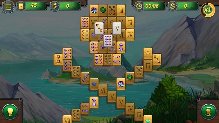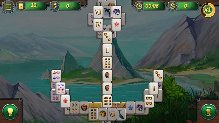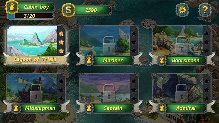Liverpool Sound and Vision Rating 9/10
Mahjong Gold is a traditional Chinese puzzle game available for download from the PlayStation Store for the PS Vita. With Mahjong: Royal Towers and Mahjong: World Contest both being exceptional Mahjong games questions will surely be asked that can the sequel Mahjong Gold match up to or perhaps even better its predecessors?
There are six different categories of levels that are referred to as contests with each contest spanning twenty levels totalling to an amazing 120 levels! Each of the six contests has a specific name including: Lagoon of Trials; Mariner; Bootsmann; Midshipman; Captain; and Admiral with each being tied to a difficulty level ranging all the way from newbie to experienced, expert, master and champion.
You start out with only one contest that you can enter with only the first level unlocked and you work your way through each and every level attempting to earn enough stars to unlock the second contest as you unlock the next level by achieving between one and three stars in each level with each star representing a successfully completed objective. The amount of stars that are required to unlock the second contest and each of the six contests thereafter are clearly highlighted on the contest and level selection menus, which is a positive and appropriate design choice as it allows the player to know exactly where they stand in regards to how close they are to unlocking the next set of levels contained within the next contest.
 Mahjong Gold has the same core premise as Mahjong: Royal Towers and Mahjong: World Contest as you attempt to pair matching tiles together. The real puzzle element of the gameplay is provided by the traditional rule of only being able to pair matching tiles from the outer edge of any group of tiles. There are tile families, such as seasons and flowers that can appear differently from one another in their appearance by their colour but can still be paired together, which is something that you really have to keep in mind when frantically trying to search for your next matching pair of tiles. There are two additional types of tiles that consist of silver tiles and gold tiles. As was the case with the games forerunners, as silver tiles are removed from the board they will automatically restore your chip bonus, while the amount of golden tiles varies from level to level, although it is a requirement that every golden tile must be removed from the board in order for you to complete each level.
Mahjong Gold has the same core premise as Mahjong: Royal Towers and Mahjong: World Contest as you attempt to pair matching tiles together. The real puzzle element of the gameplay is provided by the traditional rule of only being able to pair matching tiles from the outer edge of any group of tiles. There are tile families, such as seasons and flowers that can appear differently from one another in their appearance by their colour but can still be paired together, which is something that you really have to keep in mind when frantically trying to search for your next matching pair of tiles. There are two additional types of tiles that consist of silver tiles and gold tiles. As was the case with the games forerunners, as silver tiles are removed from the board they will automatically restore your chip bonus, while the amount of golden tiles varies from level to level, although it is a requirement that every golden tile must be removed from the board in order for you to complete each level.
There are three sets of tiles with a wide assortment of tile categories including: traditional, gold and numbers. As each of the three tile sets are completely unique in design, they really add another layer to the gameplay, as it means you can replay levels with different designs across all of the tiles resulting in it not just being about memorising the positioning of the matching tiles by parrot fashion and you can change the tile set at any given time on any level from the pause menu, which freshens up the gameplay even further. The gold tile set contains multiple references to the developer’s Fort Defense games that have received two releases on PlayStation Vita as some of the tiles include icons that are clearly nods to both Fort Defense games in regards to their enemies or powers.
There are various bonuses within the gameplay mechanics, such as tile shuffles when you have used all of the possible pairings for matching the tiles together, which needs to be recharged after use by pairing together a few tiles; alongside a skill for shading blocked tiles, while keeping available tiles brightly coloured, which is an ability that can be used throughout each level from start to finish.
There is a multiplier that becomes active once you have chained together a few quick moves to remove matching pairs of tiles from the board. The multiplier will then increase the points you earn from removing matching pairs of tiles from the board, such as a move that would have previously earned you ten points will instead earn you twenty points during the x2 multiplier.
Arguably it would have been agreeable to see more beyond the three objectives, such as producing randomly generated special tasks for levels that you have already earned three stars on; providing fresh challenges for you to complete a level within a certain number of moves, a higher level of points, a particular multiplier or a time limit that is considerably lower and harder than the three standard objectives, which would effectively act as a reward by increasing the amount of replayability for having completed a level within a particular time, within a certain number of moves, having achieved a particular multiplier or having reached an unprecedented points tally.
Scrolls appear on screen when you have achieved the requirements of a trophy or a major objective within the game or even when you have ran out of matching tiles to inform you that the shuffle bonus is available and that it will be applied automatically for you to continue your progression through the level. This is a great design choice as it is a very nice touch of detail to the game, which brings authenticity as scrolls are something you would expect from ancient Chinese tradition.
 There is some downloadable content available for Mahjong Gold in the form of the 5 star pack, 17 stars pack and 30 stars pack, which is available from the European PlayStation Store with the 5 stars pack costing just £0.79; the 17 stars pack costing £2.49 and the 30 stars pack costing £3.99. The purpose of each of the three downloadable content packs is to enable you to still be able to unlock the later levels of the game regardless of your skill or perhaps in the scenario that you want to skip ahead to a particular level that a friend may have told you about. However, it is important to state that these micro transactions are not required for you to complete the game as you earn three stars for each level you complete with a perfect performance and they are only there for people who want to unlock levels that they have not earned enough stars to otherwise do so.
There is some downloadable content available for Mahjong Gold in the form of the 5 star pack, 17 stars pack and 30 stars pack, which is available from the European PlayStation Store with the 5 stars pack costing just £0.79; the 17 stars pack costing £2.49 and the 30 stars pack costing £3.99. The purpose of each of the three downloadable content packs is to enable you to still be able to unlock the later levels of the game regardless of your skill or perhaps in the scenario that you want to skip ahead to a particular level that a friend may have told you about. However, it is important to state that these micro transactions are not required for you to complete the game as you earn three stars for each level you complete with a perfect performance and they are only there for people who want to unlock levels that they have not earned enough stars to otherwise do so.
The controls are identical to those found in Mahjong: Royal Towers and Mahjong: World Contest as it consists of a purely touch screen based control scheme. The controls consist of tapping the first tile that you would like to select and then tapping the second tile that you would like to pair it with; tapping the light bulb icon on the bottom left of the screen to switch the skill for shading blocked tiles on or off; tapping the shuffle icon on the bottom right of the screen to change the positioning of the tiles when you believe you have exhausted all of the matching pairs of tiles to progress any further; and tapping the icon to the top left of the screen to pause the game and display the pause menu with the ability to change options, such as selecting a new tile set, turning the sound and music on or off, viewing the help menu to read over the rules of the game and quitting or restarting the level. At any time during any level you can zoom in by moving your fingers outwards from the centre of the screen across the screen and you can zoom out by moving your fingers inwards towards the centre of the screen, alongside swiping across any area of the screen to move the focus of the screen to that particular area allowing you to navigate around the tiles while you are fully zoomed in.
As was previously established with its predecessors the graphics showcased in the contest provide everything that you would expect to see from a Mahjong game with colourful and detailed tile sets and backgrounds that really authenticate the experience of Mahjong.
The presentation of the game is in the same mould as Mahjong: Royal Towers and Mahjong: World Contest as it is solid with a great touch screen based user interface across various menus such as the contest menu, level selection menu and options menu, although it lacks any ability for navigation via the left and right analogue sticks, directional pad, face buttons and rear touch pad. The background of the menu screens looks very colourful and vibrant as they contain a still image in the background that represents the category of levels you have chosen.
The audio consists of the style of music that you would typically associate with Mahjong as it has a laid back and relaxing quality to it, which ties in with the graphics to provide an authentic Mahjong experience; just as the prequels had also previously achieved. There are also sound effects for when you have chosen your first tile and when you have chosen the second tile to pair it with, alongside other sound effects such as when your tile shuffle bonus has recharged and has become available to use again.
The trophy list includes twelve trophies with seven bronze trophies, four silver trophies and one gold trophy. You may not necessarily find the trophies easy due to how difficult you may find some of the requirements for each level, such as completing a level within a certain period of time; within a certain amount of moves; earning a certain amount of points; and removing a certain amount of gold tiles, but the majority of the trophies are naturally earned through playing the game and will not require you to deviate from the objectives you have been set for each level.
The first trophy you will most likely earn will be the Trophy of Trials bronze trophy for completing the first stage, which should be relatively easy providing that you know your way around Mahjong and even if you do not, then you can learn quickly enough as you progress through the first stage, while the other easier trophies include the Privateer Trophy bronze trophy for collecting thirty stars, which is achieved by earning between one and three stars from your performance spread across each of the levels, so this should be easily achieved by the end of the first contest which consists of twenty levels; the Long John Silver silver trophy for using the bonus fifty times by shuffling the tiles a total of fifty times spread across the levels; and the Sharp Blade silver trophy for removing 1,000 pairs of tiles, which should be completed naturally within twenty to thirty levels. The trophies are mostly aimed at completing all of the levels within each of the six contests and while they provide six bronze trophies; they are certainly going to take a fair amount of time to complete all of the 120 levels required for those six particular trophies.
 The harder trophies are the Bounty Hunter silver trophy for scoring 100,000 points, although that is an overall total of points, rather than within a single level or contest and you can view your progress towards the figure from the contests menu and level selection menu, so you will earn the trophy naturally as you progress through the second contest; the Sea Dog bronze trophy for achieving the x5 multiplier for consistently matching pairs of tiles very quickly; and the Top Marks gold trophy for completing thirty levels with the highest score in each. Players should estimate, depending upon skill and a good trophy guide to provide some helpful tips, that it will take around ten hours to 100% the trophy list.
The harder trophies are the Bounty Hunter silver trophy for scoring 100,000 points, although that is an overall total of points, rather than within a single level or contest and you can view your progress towards the figure from the contests menu and level selection menu, so you will earn the trophy naturally as you progress through the second contest; the Sea Dog bronze trophy for achieving the x5 multiplier for consistently matching pairs of tiles very quickly; and the Top Marks gold trophy for completing thirty levels with the highest score in each. Players should estimate, depending upon skill and a good trophy guide to provide some helpful tips, that it will take around ten hours to 100% the trophy list.
The difficulty levels are pretty much the same as before as there are difficulty levels by name as you can see from the contests selection menu, although the only things that can really become any harder are the requirements for achieving stars, such as lowering the number of moves you can make within a level; increasing the points total you need to score; lowering the period of time you have to complete a level; and increasing the amount of gold tiles that you have to remove before completing the level. The point being is that this is still essentially Mahjong and if you are pretty good at spotting the matching pairs of tiles, then none of these harder requirements will feel like restrictions, so while there are technically various difficulty levels, it will really depend upon your own level of skill at playing Mahjong as to whether you feel any difference between them.
There are no online multiplayer modes or online leaderboards, which is a bit disappointing as it would have added another competitive edge to the gameplay. Players could imagine there being an online battle system in which you and your online opponent are attempting to complete the level first and that you could even perhaps bet some of your points tally from the single player with customisation in the form of how many consecutive rounds you would like to play and how many points you would like to bet, whereas the online leaderboards could have had in place a structure for the best times for each level; the largest number of points to be earned for each level; the highest multiplier to be achieved for each level; the lowest number of moves for each level to be completed within; and then all of the same leaderboards for each of the six contests.
Overall, if you like Mahjong games then you really should purchase Mahjong Gold, regardless of whether you already own Mahjong: Royal Towers and Mahjong: World Contest or not as Mahjong Gold provides 120 levels of great Mahjong puzzles to solve, which will have you returning to the game for many hours as you attempt to improve your performance enough to achieve three stars on every level. If you are a fan of Mahjong or puzzle games, then Mahjong Gold is a must purchase, especially considering all of the replayability and levels you will enjoy for just £3.99.
Jason Bonnar
Analysis
- Title: Mahjong Gold
- Developer: 8 Floor Games
- Publisher: 8 Floor Games
- System: PS Vita
- Format: PSN Download
- Cross-Buy: No
- Cross-Play: No
- Multiplayer: No
- Memory Card Space Required: 100MB